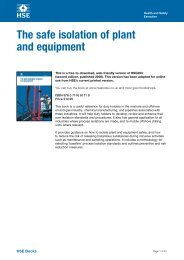HSG123: Working together on firework displays - Health and Safety ...
HSG123: Working together on firework displays - Health and Safety ...
HSG123: Working together on firework displays - Health and Safety ...
You also want an ePaper? Increase the reach of your titles
YUMPU automatically turns print PDFs into web optimized ePapers that Google loves.
Figure 9 Firer wearing<br />
protective clothing,<br />
safety goggles <strong>and</strong><br />
ear protectors (see<br />
paragraphs 86-87)<br />
<strong>Health</strong> <strong>and</strong> <strong>Safety</strong><br />
Executive<br />
n When mortar tubes are racked <str<strong>on</strong>g>together</str<strong>on</strong>g>, support them with a firmly fixed sturdy<br />
frame, eg by wooden stakes, so they cannot topple over (Figure 8a).<br />
n Bury or s<strong>and</strong>bag single mortar tubes deep enough to prevent them toppling<br />
over, <strong>and</strong> inclined away from spectators (Figures 8b-d). Take precauti<strong>on</strong>s to<br />
ensure a misfire in <strong>on</strong>e mortar tube will not disrupt other mortar tubes.<br />
n Do not fire single shot maro<strong>on</strong>s from metal mortar tubes.<br />
n Ensure mortar tubes are str<strong>on</strong>g <strong>and</strong> durable enough for the shells. When<br />
deciding whether the mortar tube material should be cardboard, plastic<br />
or metal, think about using a material that would not fragment or produce<br />
hazardous debris if a shell malfuncti<strong>on</strong>ed in the mortar tube. If a mortar tube is<br />
made of material which could produce hazardous debris, s<strong>and</strong>bag or barricade<br />
it. Use enough s<strong>and</strong>bags or barricading to ensure firers <strong>and</strong> spectators would<br />
be protected if a shell malfuncti<strong>on</strong>ed in the mortar tube. Research suggests<br />
that you may get better protecti<strong>on</strong> from hazard debris if s<strong>and</strong>bags or protective<br />
barricades are in c<strong>on</strong>tact with the mortar tubes. An air gap between the mortar<br />
tubes <strong>and</strong> the barricade will reduce the effectiveness of the protecti<strong>on</strong>.<br />
n Always clean out mortar tubes <strong>and</strong> check they are reas<strong>on</strong>ably dry before use.<br />
n Ensure mortar tube bungs are held firmly in place <strong>and</strong> checked before firing<br />
each display.<br />
n Preferably avoid reloading mortar tubes during a display. Where mortar tubes<br />
are reloaded, group them according to size to help avoid shell/mortar tube<br />
mismatches.<br />
Firing the display<br />
Protective clothing <strong>and</strong> equipment<br />
86 Firers are advised to wear substantial outer clothing made of wool or some fireretardant<br />
material such as probanised cott<strong>on</strong>. They are also recommended to wear<br />
gloves, safety goggles, safety helmets <strong>and</strong> substantial closed footwear made of<br />
leather or similar material (Figure 9).<br />
87 Firers are advised to wear ear protectors or other suitable hearing protecti<strong>on</strong>.<br />
Where the firers are at work, the C<strong>on</strong>trol of Noise at Work Regulati<strong>on</strong>s 2005 16 will<br />
apply. This means display operators have to assess the exposures of employees<br />
<strong>and</strong> themselves to noise during firing, <strong>and</strong> where necessary take adequate<br />
measures to protect their hearing from damage (Figure 9). For electric firing, it may<br />
be possible to site the firing point far enough away from the <strong>firework</strong>s for noise<br />
exposure to be below the acti<strong>on</strong> levels given in the Regulati<strong>on</strong>s. In this case ensure<br />
that firers retire to that point whenever firing is in progress.<br />
Firing procedures<br />
88 It is important that the activities of the firing team are co-ordinated to ensure<br />
that every<strong>on</strong>e is in a safe positi<strong>on</strong> whenever <strong>firework</strong>s are about to go off. Firers<br />
should be at least ten metres away from ground maro<strong>on</strong>s.<br />
89 If a mortar tube is to be reloaded with a shell, clear it of smouldering debris<br />
before a further shell is inserted.<br />
90 Take any mortar tube showing signs of distorti<strong>on</strong>, dangerous corrosi<strong>on</strong> or<br />
damage out of use immediately.<br />
Misfires<br />
91 Leave a <strong>firework</strong> which fails to ignite for at least 30 minutes. In most cases,<br />
it will then be best to immerse it in a bucket of water. Never positi<strong>on</strong> any part of<br />
the body over a misfired <strong>firework</strong>. In the particular case of a shell in a mortar tube,<br />
never look down the mortar tube <strong>and</strong> do not pull a shell out of the mortar<br />
<str<strong>on</strong>g>Working</str<strong>on</strong>g> <str<strong>on</strong>g>together</str<strong>on</strong>g> <strong>on</strong> <strong>firework</strong> <strong>displays</strong> Page 19 of 32







